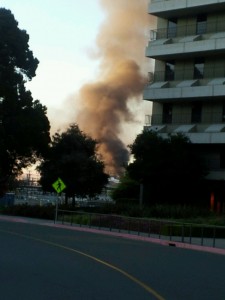
The question of how Monday's fire at the Chevron refinery affected Bay Area air remains, shall we say, murky. On Thursday the Bay Area Air Quality Management District, which is charged with monitoring what we breathe, backtracked on an earlier statement that air contaminants remained within California state standards.
One chemical, acrolein, was above safe standards set by the state's Office of Environmental Health Hazard Assessment, the BAAQMD said in a media release. Acrolein causes runny noses and eye irritation, according to the U.S. Environmental Protection Agency.
Here's the text of the BAAQMD media release:
The Air District is continuing its investigation and analysis of air monitoring data from the Chevron fire on August 6.
The Air District recently released the results of eight air samples taken during the Chevron fire.
In all but one sample the District measured 23 compounds. One sample contained trace amounts of four aldehyde compounds in addition to the 23 compounds identified in the other samples.
In a previous statement, it was reported that Air District and Contra Costa County air sample results showed all toxic air contaminants were below Office of Environmental Health Hazard
Assessment Reference Exposure Levels, or RELS. That initial statement was incorrect. Although all sample results were within the background levels of compounds found in Bay Area air, acrolein was above OEHHA’s Reference Exposure Level.
Levels of acrolein throughout the Bay Area are commonly above the Reference Exposure Level. Levels routinely range between 1 and 4.5 parts per billion. The level of acrolein in one of eight samples was 3.2 parts-per-billion. Levels of acrolein in the other seven samples taken throughout Richmond and nearby locations were below the Reference Exposure Level. Acrolein is an oxygenated hydrocarbon similar to ethanol.
While air samples taken near the facility detected normal background levels of toxic air contaminants, there was the potential for significant smoke in the area that impacted residents in the downwind neighborhoods. The likely source of health impacts from the fire is particulate matter from smoke.
Stationary real-time particulate matter monitors in upwind areas did not pick up elevated levels of the particulate matter during the fire. Filter-based data from an air quality monitoring station in San Pablo, two miles from the Chevron facility, was collected following the fire and is being analyzed for particulate matter levels. Results are expected in the next two weeks.
Particulate matter has immediate health impacts – itchy, watery eyes, increased respiratory symptoms such as irritation of the airways, coughing or difficulty breathing and aggravated asthma.
The Bay Area Air Quality Management District (www.baaqmd.gov) is the regional agency responsible for protecting air quality in the nine-county Bay Area.